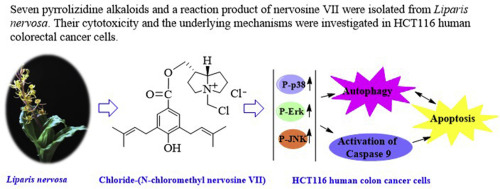当前位置:
X-MOL 学术
›
Phytochemistry
›
论文详情
Our official English website, www.x-mol.net, welcomes your
feedback! (Note: you will need to create a separate account there.)
Pyrrolizidine alkaloids from Liparis nervosa with antitumor activity by modulation of autophagy and apoptosis
Phytochemistry ( IF 3.2 ) Pub Date : 2018-09-01 , DOI: 10.1016/j.phytochem.2018.06.001 Lin Chen , Shuai Huang , Chun Ying Li , Feng Gao , Xian Li Zhou
Phytochemistry ( IF 3.2 ) Pub Date : 2018-09-01 , DOI: 10.1016/j.phytochem.2018.06.001 Lin Chen , Shuai Huang , Chun Ying Li , Feng Gao , Xian Li Zhou

|
Seven pyrrolizidine alkaloids, nervosine X-XV and nervosine VII N-oxide, together with a reaction product, namely chloride-(N-chloromethyl nervosine VII), were isolated from Liparis nervosa. Their structures were elucidated by extensive spectroscopic analyses. Most of these compounds were investigated for their cytotoxicity in vitro against HCT116 human cancer cell line, and the results showed that chloride-(N-chloromethyl nervosine VII) induced tumor cell death in a dose-dependent manner. Furthermore, the mechanisms underlying its cytotoxicity were investigated, including apoptosis and autophagy. Apoptosis in HCT116 cells was associated with up-regulation of caspase-3 and -9 expressions by activation of the mitochondrial pathway. The autophagy inducing effect was associated with the regulation of autophagic markers, including LC3-II, p62, and Beclin 1. Mechanistic studies showed that JNK, ERK1/2, and p38 MAPKs signaling cascades play an important role in chloride-(N-chloromethyl nervosine VII) induced autophagy and apoptosis.
中文翻译:

来自神经唇脂的吡咯里西啶生物碱通过调节自噬和细胞凋亡具有抗肿瘤活性
从 Liparis nervosa 中分离出七种吡咯里西啶生物碱,即神经氨酸 X-XV 和神经氨酸 VII N-氧化物,以及反应产物,即氯化物-(N-氯甲基神经氨酸 VII)。通过广泛的光谱分析阐明了它们的结构。大多数这些化合物在体外对 HCT116 人癌细胞系的细胞毒性进行了研究,结果表明氯化物-(N-氯甲基神经氨酸 VII)以剂量依赖性方式诱导肿瘤细胞死亡。此外,研究了其细胞毒性的机制,包括细胞凋亡和自噬。HCT116 细胞的凋亡与通过激活线粒体途径上调 caspase-3 和 -9 的表达有关。自噬诱导作用与自噬标志物的调节有关,包括 LC3-II、p62、
更新日期:2018-09-01
中文翻译:

来自神经唇脂的吡咯里西啶生物碱通过调节自噬和细胞凋亡具有抗肿瘤活性
从 Liparis nervosa 中分离出七种吡咯里西啶生物碱,即神经氨酸 X-XV 和神经氨酸 VII N-氧化物,以及反应产物,即氯化物-(N-氯甲基神经氨酸 VII)。通过广泛的光谱分析阐明了它们的结构。大多数这些化合物在体外对 HCT116 人癌细胞系的细胞毒性进行了研究,结果表明氯化物-(N-氯甲基神经氨酸 VII)以剂量依赖性方式诱导肿瘤细胞死亡。此外,研究了其细胞毒性的机制,包括细胞凋亡和自噬。HCT116 细胞的凋亡与通过激活线粒体途径上调 caspase-3 和 -9 的表达有关。自噬诱导作用与自噬标志物的调节有关,包括 LC3-II、p62、











































 京公网安备 11010802027423号
京公网安备 11010802027423号